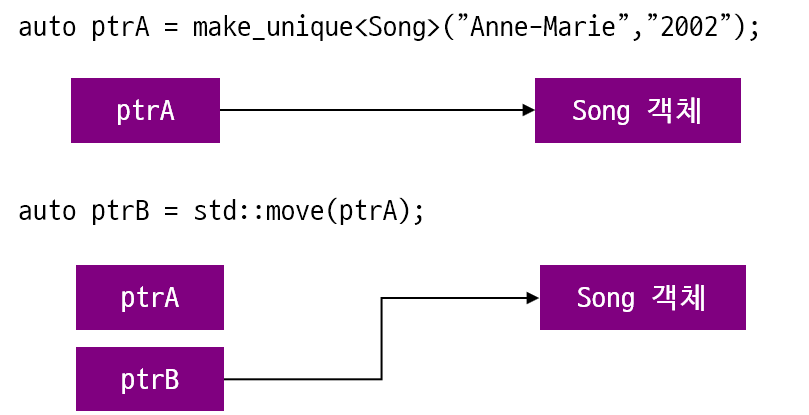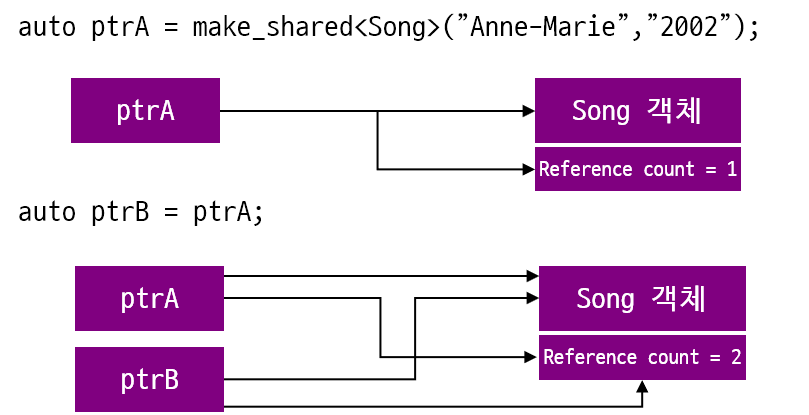Smart pointer(C++11)
스마트 포인터에는 크게 다음 3가지의 포인터가 존재한다.
- unique_ptr
- shared_ptr
- weak_ptr
C++03의 auto_ptr은 unique_ptr을 만들려던 시도의 실패작이므로 사용해선 안된다.
1. unique_ptr

unique_ptr는 모던 C++에 속한 스마트 포인터 3가지 중 하나로서 std 네임스페이스에 속해있고 <memory> 헤더파일에 속한 표준 포인터이다.
다수의 인스턴스가 하나의 객체를 가르키는것은 프로그램 구조상 복잡해 지기 때문에 하나의 소유자만을 허용하기 위한 용도이다.
새 소유자로 이동은 가능하지만 복사하거나 공유할 수 없습니다. unique_ptr은 c++03의 사용하지 않는 auto_ptr을 대체합니다.
1.1 unique_ptr Example
#include <memory>
#include <vector>
#include <list>
#include <string>
#include <stdio.h>
using namespace std;
class Song {
private:
string title;
string artist;
unique_ptr<list<string>> producers;//Song class는 unique_ptr을 소유.
public:
// list<string> 기본 생성자와 make_unique를 이용한 초기화
Song(string artist, string title) : producers(make_unique<list<string>>()) {
this->artist = artist;
this->title = title;
}
string getTitle() {
return title;
}
string getArtist() {
return artist;
}
};
unique_ptr<Song> SongFactory(const string& artist, const string& title)
{
return make_unique<Song>(artist, title);
}
void SongVector()
{
vector<unique_ptr<Song>> songs;
//unique_ptr 생성 및 vector에 추가
songs.push_back(make_unique<Song>("Anne-Marie", "2002"));
songs.push_back(make_unique<Song>("Namie Amuro", "Funky Town"));
songs.push_back(SongFactory("Twice","FANCY"));
auto song = make_unique<Song>("Ayumi Hamasaki", "Poker Face");
unique_ptr<Song> song2 = std::move(song);//song은 "Ayumi Hamasaki" & "Poker Face"에 접근 할 수 없다.
//songs.push_back(song2);//에러! song2는 song2라는 레퍼런스가 연결을 맺고 있으므로 move를 통해 연결을 옮겨주어야 한다.
songs.push_back(std::move(song2));
for (const auto& song : songs)
{
printf("Artist: %15s Title: %s\n", song->getArtist().c_str(), song->getTitle().c_str());
}
song.reset(); // song이 가리키고 있는 메모리 영역을 삭제함.
}
int main() {
SongVector();
}
1.2 unique_ptr 메모리 해제
메모리 할당된 내용을 해제하기 위해서는 std::unique_ptr::release를 이용해서 Song *relSong = song.release();을 이용해 사용권을 해제 할 수 있다.
그러나 이경우는 delete(relSong);처럼 delete키워드를 이용하여 수동으로 메모리를 해제 해 주어야 한다.
또한 함수 내부에서 unque_ptr을 생성했을때, 스택에 들어있는 unique_ptr은 함수가 종료되면 자동적으로 소멸자를 부르게 된다.
즉 정리하자면 메모리를 해제하는 방법에는 크게 3가지 방법이 있다.
- std::unique_ptr::reset()
- std::unique_ptr::release()로 포인터를 받아와 수동으로 delete()
- 함수가 종료되면 자동적으로 delete 된다.
그러나 공통적으로 내부 소멸자는 호출되지만 내부 변수가 포인터 등의 경우 자동으로 제거를 보장해주는것이 아니기 때문에 delete 키워드를 통하여 동적할당 한 부분은 제거하도록 명시 해 주어야 한다.
int* do_something2() {
std::unique_ptr<int[]> pa = std::make_unique<int[]>(1000);
std::cout << "pa[0] : " << pa[0] << std::endl;
pa[0] = 10;
// pb 에 소유권을 이전.
std::unique_ptr<int []> pb = std::move(pa);
std::cout << "pb[0] : " << pb[0] << std::endl;
int *p = pb.get();
std::cout << p[0] << std::endl;
return pb.get();
}
int main() {
int *p = do_something2();
std::cout << p[0] << std::endl;
_sleep(3000);
std::cout << "프로그램 종료";
}
사실 위의 코드와 같이 unique_ptr의 get을 이용하여 주소값을 넘기는 것은 unuque_ptr의 목적과 다른 잘못 된 코드이다.
하지만 함수가 종료되면 자동적으로 delete되는것을 확인하기 위해 위와 같은 코드를 작성하였다. _sleep(3000)이 불리기 전에 메모리가 해제되어 main에서 p[0]를 출력하면 쓰레기 값이 출력되는것을 볼 수 있다.
1.3 함수에서의 unique_ptr
void do_something(A* ptr) { ptr->do_sth(3); }
int main() {
std::unique_ptr<A> pa(new A());
do_something(pa.get());
}
unique_ptr은 함수로 전달이 불가능하기에 get()을 이용한 실게 객체의 주솟값을 넘겨줄수가 있으나 이런 경우는 유일한 소유권의 의미를 버린 잘못된 방법이기 때문에 위와 같이 코드를 작성해서는 안된다.
#include <iostream>
#include <memory>
class A {
int *data;
public:
A() {
std::cout << "자원을 획득함!" << std::endl;
data = new int[100];
}
void some() { std::cout << "일반 포인터와 동일하게 사용가능!" << std::endl; }
~A() {
std::cout << "자원을 해제함!" << std::endl;
delete[] data;
}
};
void do_something() {
std::unique_ptr<A> pa(new A());
std::cout << "pa : ";
pa->some();
// pb 에 소유권을 이전.
std::unique_ptr<A> pb = std::move(pa);
std::cout << "pb : ";
pb->some();
pa->some();//error? no!
}
int main() { do_something(); }
또한 위의 코드처럼 소유권은 이전한 후에도 pa->some()을 접근하면 맴버변수를 접근하지 않았기 때문에 정상적으로 동작하긴 하나, 이러한 방법을 올바른 방법이 아니므로 사용해서는 안된다. 만약 some() 함수 안에 data를 접근해 data[0]을 출력하는 코드가 들어있다면 오류가 발생한다.
2. shared_ptr

shared_ptr은 둘 이상의 소유자가 메모리에 있는 객체를 공유하는 C++ 표준 라이브러리의 스마트 포인터이다. shared_ptr을 초기화한 후 복사, 함수 인수의 값으로 전달 및 다른 shared_ptr 인스턴스로 할당할 수 있다. 모든 인스턴스는 동일한 객체를 가리키고 새 shared_ptr이 추가되거나 범위를 벗어나거나 다시 설정될 때마다 하나의 “제어 블록”에 대한 액세스를 공유한다. 참조 횟수가 0에 도달하면 delete 키워드를 사용하여 메모리를 해제 하게 된다.
shared_ptr Example
#include <memory>
#include <vector>
#include <list>
#include <string>
#include <iostream>
using namespace std;
class Song {
private:
string title;
string artist;
public:
Song(string artist, string title) {
this->artist = artist;
this->title = title;
}
string getTitle() {
return title;
}
string getArtist() {
return artist;
}
};
void SongVector()
{
//shared_ptr 생성 방법
auto sp1 = make_shared<Song>("The Beatles", "Im Happy Just to Dance With You");
shared_ptr<Song> sp2(new Song("Twice", "Fancy"));
shared_ptr<Song> sp3(nullptr);
sp3 = make_shared<Song>("Elton John", "I'm Still Standing");
//shared_ptr 변경 및 초기화 방법
auto sp4(sp2);//복사 생성자를 이용한 초기화 ref_count++
auto sp5 = sp2;//sp5에 sp2 할당 초기화 ref_count++
cout << sp5.use_count() << endl;//3
}
int main() {
SongVector();
}
3. weak_ptr
weak_ptr은 하나 이상의 shared_ptr 인스턴스가 소유하는 객체에 대한 접근을 제공하지만, 소유자의 수에는 포함되지 않는 스마트 포인터이다.
shared_ptr은 참조 횟수(reference count)를 기반으로 동작하는 스마트 포인터인데 만약 서로가 상대방을 가리키는 shared_ptr를 가지고 있다면, 참조 횟수는 절대 0이 되지 않으므로 메모리는 영원히 해제되지 않는다.
이렇게 서로가 상대방을 참조하고 있는 상황을 순환 참조(circular reference)라고 한다.
weak_ptr은 바로 이러한 shared_ptr 인스턴스 사이의 순환 참조를 제거하기 위해서 사용된다.
References
https://docs.microsoft.com/ko-kr/cpp/cpp/smart-pointers-modern-cpp?view=vs-2019 http://tcpschool.com/cpp/cpp_template_smartPointer